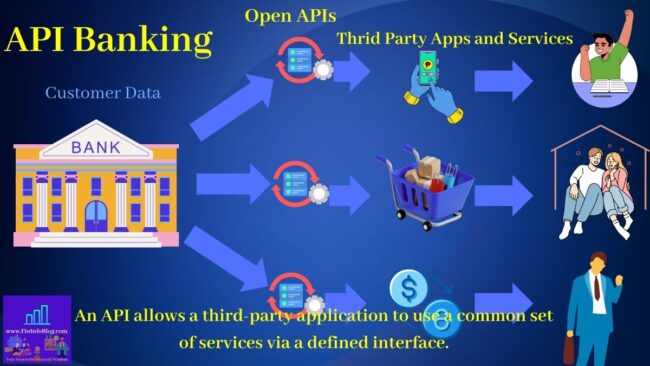API Banking Revolution
In the realm of modern banking, the terms “API Banking” and “Open Banking API” are becoming increasingly prevalent. Let’s explore these concepts to understand what API Banking is, what Open Banking API entails, and how bank API integration is revolutionizing the financial landscape.
What is banking through APIs?
Technology and Banking Integration
Application Programming Interface (API) Banking, sometimes referred to as Open Banking API, is a technology that permits safe data interchange and communication between various banking systems and outside apps. Banks expose their digital portals to authorized third-party developers so they can use different financial services, make transactions, and access consumer account information. Said another way, it can be compared to a secure language used by software programs and banks to communicate with one another.

What Is the Process of API Banking?
The key to improving the efficiency of our banking encounters is API banking. Imagine it like follows: Your apps are your buddies, and your bank is like a magical assistant. Your pals can make payments for you or contact the magical aid for information about your account. Your buddies can access the info and everything will remain safe thanks to the miraculous assistant. It resembles having a personal financial assistant.
Is banking via APIs safe and secure?
Because banks take extra security precautions, API banking is usually safe. To ensure that only the bank and the app can access your data, they encrypt it using a secret code. Additionally, they watch out for any cunning individuals attempting to obtain your info. As with anything online, though, there’s always a chance that someone may try to steal your information, so make sure you only use reliable banks and apps.
Bank API Integration: Its Advantages
Bank The process of integrating your systems with a bank’s APIs is known as API integration. Numerous benefits come with this integration, including automated procedures and real-time access to payment information. Here are a few advantages:
Current Information:
Businesses can obtain real-time payment information through bank API connection. This implies that you can accurately and swiftly process payments.
Cost savings:
It gets rid of the necessity for pricey file transfers and cuts down on the time and money spent on human labor.
One-time Setup:
You just need to establish the connection once after integrating with the APIs of a bank. Integrations with new customers in the future become more simpler.
Enhanced Security:
Secure authentication techniques are used by bank APIs to protect your financial information from unwanted access
API Technology: understand the fundamentals of technology.
APIs are essential channels for data interchange and service integration in the banking industry. They help to create a more integrated and effective financial environment by enabling banks to provide a wide range of digital services. Providing cutting-edge services and enhancing client experiences depend on this integration.
Advantages of Banking API Adoption
Enhanced agility, better user experience, process standardization, greater alliances, and community building are just a few of the indirect advantages that APIs provide. They play a key role in improving the flexibility and responsiveness of banking operations to the demands of the market.

- Banking with Application Programming Interfaces
- Protocol for Simple Object Access (SOAP)
The SOAP protocol defines the structure of messages and communication techniques through the usage of XML for data transport. It is a well-liked option in banking apps because of its strong standards and security features.
Transferring Representational States (REST)
Because of its ease of use and online interoperability, the REST architectural style has grown in favor. Because it makes use of current internet protocols, web-based banking services can effectively use it.
XML-RPC and JSON Protocols
Banking APIs use lightweight protocols like XML-RPC and JSON-RPC to convey data. They are appropriate for a range of financial applications since they are less complex and need less bandwidth than SOAP.
Different Banking API Types
Inside APIs
Internal APIs enhance operational effectiveness and data management by facilitating communication amongst a bank’s many divisions and systems.
Associated APIs
They enable safe data interchange and service integration, and they are utilized by corporations and business partners in accordance with their contractual obligations to the bank.
Open APIs
These APIs, like payment gateways, provide for greater access to and engagement with the bank’s services for everyone who satisfies predetermined criteria.
API Management in Financial Services
In banking, ensuring consistency, security, and efficient lifecycle management depend heavily on the governance of APIs. Assuring regulatory compliance, establishing guidelines for API usage, and implementing best practices for API development and deployment are all included in this.
Security Factors Should Be Considered When Managing APIs
Security in the financial industry is a top priority. To guard against cyberattacks, illegal access, and data breaches, APIs must be well-secured. This include monitoring API usage, utilizing sophisticated authentication and encryption techniques, and upholding strict data integrity and confidentiality guidelines.
The Future and Difficulties of API Technology in Banking
Even though API technology is revolutionary, it also presents difficulties with regard to maintaining security, controlling a larger attack surface, and integrating with legacy systems. API technology will become increasingly important as the banking sector develops since it will facilitate fintech alliances, innovation, and digital transformation.
Conclusion
In the banking sector, API technology is revolutionizing client involvement and service delivery by opening up new channels. APIs are going to be essential tools for banks as they embrace digital transformation and provide more inventive, connected, and efficient banking experiences.
Q&As
How is the banking sector being changed by API technology?
What security ramifications come with using APIs in banking?
Which kinds of application programming interfaces are frequently employed by banks?
In what ways do banks control and oversee their API infrastructure?
What difficulties does API technology present for the banking industry?

Prominent banks in India, such as SBI, HDFC Bank, AXIS Bank, ICICI Bank, and Yes Bank, offer renowned API services. These services are known as SBI API, HDFC Bank API, AXIS Bank API, ICICI Bank API, and Yes Bank API, respectively.
Don’t Miss These
How to behave with branch managers?
Banking Technology :Embrace the Latest Innovations in Banking Technology for a Bright 2023










1 thought on “API Banking Revolution: Combination of Technology and Banking”